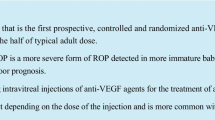Abstract
To investigate cord arterial blood sample and the relationship between birth stress and intraocular pressure in infants at 5 min after delivery. The IOP measurements were taken using Tonopen-Avia tonometer to 158 newborns (158 eyes) at 5th min after birth, in a university hospital. Cord blood was collected within 3 min after delivery. Intraocular pressure, gender, gestation period, mode of delivery, and birth weight of newborns were noted from medical records. Sixty-two babies were delivered by normal vaginal delivery (NVD) and 96 by cesarian section (C/S). Mean IOP of NVD and C/S groups were 19.56 ± 3.84 and 17.42 ± 3.50, respectively. There was significant difference of mean IOP between two groups. (p < 0.001) There were significant differences between two groups regarding APGAR score (p < 0.001) and cord blood adrenaline (p = 0.003), noradrenaline (p = 0.008), and cortisol (p < 0.001) levels. There was no difference between infant corneal thickness measurements (p = 0.698). In correlation analyses, there is a strong negative correlation between the labor type and postpartum measurements except corneal thickness. Correlation analyses of the 5th min intraocular pressure of the groups individually revealed significant correlation in the NVD group. The conclusion is that the intraocular pressure of newborn infants was higher in NVD delivery compare to C/S. Blood hormonal changes in different anesthesia types and physical stress was thought as the main reason of this result.
Similar content being viewed by others
References
Chesnutt AN (2004) Physiology of normal pregnancy. Crit Care Clin 20:609–615
Carlin A, Alfirevic Z (2008) Physiological changes of pregnancy and monitoring. Best Pract Res Clin Obstet Gynaecol 22:801–823
Reddy SC, Alias R (2014) Tono-pen measurement of intraocular pressure under topical anaesthesia in full term normal newborns. Int J Ophthalmol 7:92–94
Karahan E, Zengin MO, Tuncer I, Zengin N (2015) Correlation of intraocular pressure with central corneal thickness in premature and full-term newborns. Eur J Ophthalmol 25:14–17
Lindenmeyer RL, Farias L, Mendonça T, Fortes Filho JB, Procianoy RS, Silveira RC (2012) Intraocular pressure in very low birth weight preterm infants an its association with postconceptional age. Clinics 67:1241–1245
Ng PC, Tam BS, Lee CH, Wong SP, Lam HS, Kwok AK et al (2008) A longitudinal study to establish the normative value and to evaluate perinatal factors affecting intraocular pressure in preterm infants. Invest Ophthalmol Vis Sci 49:87–92
Uva MG, Reibaldi M, Longo A, Avitabile T, Gagliano C, Scollo D et al (2011) Intraocular pressure and central corneal thickness in premature and full-term newborns. JAAPOS 15:367–369
Zengin N, Zengin MÖ, Karahan E, Tuncer İ (2014) Alterations in intraocular pressure and central corneal thickness in premature newborns. Behcet Uz Cocuk Hast Derg 4:20–24
Irestedt L, Lagercrantz H, Hjemdahl P, Hägnevik K, Belfrage P (1982) Fetal and maternal plasma catecholamine levels at elective cesarean section under general or epidural anesthesia versus vaginal delivery. Am J Obstet Gynecol 142:1004–1010
Faxelius G, Lagercrantz H, Yao A (1984) Sympathoadrenal activity and peripheral blood flow after birth: comparison in infants delivered vaginally and by cesarean section. J Pediatr 105:144–148
Miller NM, Fisk NM, Modi N, Glover V (2005) Stress responses at birth: determinants of cord arterial cortisol and links with cortisol response in infancy. BJOG 112:921–926
Victoria NC, Murphy AZ (2015) The long-term impact of early life pain on adult responses to anxiety and stress: Historical perspectives and empirical evidence. Exp Neurol. doi:10.1016/j.expneurol.2015.07.017
Miyazaki Y, Matsuo T, Kurabayashi Y (2000) Immobilization stress induces elevation of intraocular pressure in rabbits. Ophthalmic Res 32:270–277
Brody S, Erb C, Veit R, Rau H (1999) Intraocular pressure changes: the influence of psychological stress and the Valsalva maneuver. Biol Psychol 51:43–57
Shahid E, Shaikh A (2013) Effect of different eye speculums on intra ocular pressure. Effect of different eye speculums on intra ocular pressure. J Pak Med Assoc 63:1278–1280
Gregory KD, Jackson S, Korst L, Fridman M (2012) Cesarean versus vaginal delivery: whose risks? Whose benefits? Am J Perinatol 29:7–18
Kass MA, Sears ML (1977) Hormonal regulation of intraocular pressure. Surv Ophthalmol 22:153–176
Razeghinejad MR, Katz LJ (2012) Steroid-induced iatrogenic glaucoma. Ophthalmic Res 47:66–80
Mikheytseva I, Lipovetskaya E, Kopp O, Mozaffarieh M, Grieshaber MC, Flammer J et al (2009) Adrenaline-induced chronic ocular hypertension in adult rabbits. Klin Monbl Augenheilkd 226:332–336
Fitzgerald PJ (2009) Is elevated noradrenaline an aetiological factor in a number of diseases? Auton Autacoid Pharmacol 29:143–156
Cunningham AJ, Barry P (1986) Intraocular pressure–physiology and implications for anaesthetic management. Can Anaesth Soc J 33:195–208
Acknowledgments
This study was supported by Medical Device Companies for laboratory test expenses.
Author contributions
Involved in design and conduct of the study (AE, UC, OFO); preparation and review of the study (UC, BC, GK, NZK, BTB); data collection (AE, JCUA).
Author information
Authors and Affiliations
Corresponding author
Ethics declarations
Conflict of interest
None of the authors has financial or proprietary interests in any material or method mentioned.
Rights and permissions
About this article
Cite this article
Elbay, A., Celik, U., Celik, B. et al. Intraocular pressure in infants and its association with hormonal changes with vaginal birth versus cesarean section. Int Ophthalmol 36, 855–860 (2016). https://doi.org/10.1007/s10792-016-0215-6
Received:
Accepted:
Published:
Issue Date:
DOI: https://doi.org/10.1007/s10792-016-0215-6




